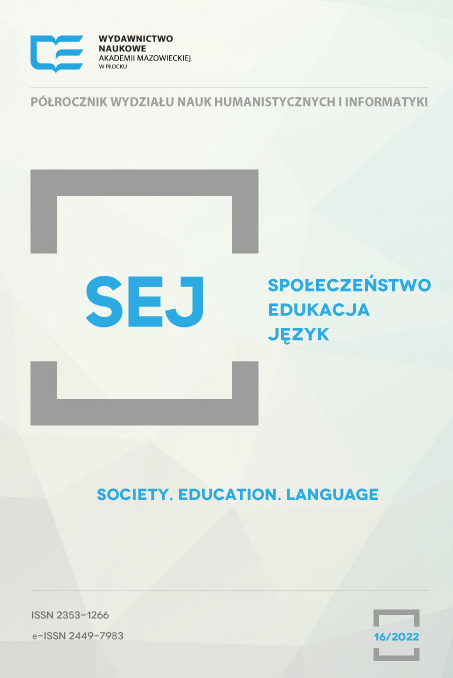IMAGE OF CHILDREN WITH ASPERGER’S SYNDROME IN OPINIONS OF TEACHERS
DOI:
https://doi.org/10.19251/sej/2022.16(5)Keywords:
social distance, stigma, Asperger′s Syndrome, teacherAbstract
The goal of the research was recognition of the extent of social distance created by teachers towards children with Asperger's syndrome.
Material and methods: Research was conducted in a group of 200 primary education teachers. These were individuals living in cities, aged 25-32 with a bachelor's degree.
The horizontal analysis consisted of the concept of the social distance (Hall, 2001), the Goffman's stigmatization option and the output of social psychology of the stigma (Heathertorn, Kleck, Hebl, Hull 2008)
Results: according to the respondents, children with Asperger's syndrome are commonly met in schools. They often face difficulties in relationships with their peers. They are withdrawn, lonely, maladjusted but not aggressive. They do not pose a threat. This results is a relatively minor social distance towards students with Asperger's syndrome. Surveyed individuals expressed a willingness to accept such children as family members, organ donors and students of mass education. The knowledge revealed by the respondents about the causes of Asperger syndrome is disturbing though. It was established that 20% of the respondents associate it with vaccinations. The media are usually the source of such information.
Conclusions: Findings show that a child with Asperger’s syndrome is considered dually weak; as a child and as a person with a disability. Also, everyday immediate relationships at school allow getting to know such a child and to eliminate fears inducted by individuals with mental health issues. What it means is that inclusive education meets its goals as a recounter of the disabled with the able-bodied. Popularizing scientific knowledge about reasons and results of Asperger syndrome is essential to prevent the spreading of prejudice against vaccinations.
References
Bibliography
Bogardus, E. S.(1933). A Social Distance Scale. Sociology and Social Research, 17, 265–271. Pobrane z: https://www.brocku.ca/MeadProject/Bogardus/Bogardus_1933.html
Brannon L.,( 2002), Związki. W: L. Brannon, Psychologia rodzaju. Kobiety i mężczyźni: podobni czy różni, przekł. M. Kacmajor. Gdańsk, GWP.
Buss D. M., (2001), Psychologia ewolucyjna. Jak wytłumaczyć społeczne zachowania człowieka. Najnowsze koncepcje, przekł. M. Orski. Gdańsk, GWP.
Centers for Disease Control and Prevention, CDC, 2016
Educational Information System, 2014,
Hall E.T. (2001) Ukryty wymiar , Muza SA, Warszawa, E. Goffman, (1963) Stigma: notes on the
managment of a spoiled identity, Simon and Schuster, New York, Heathertorn T., Kleck R., Hebl M., Hull J. (2008), Społeczna psychologia piętna, Warszawa, PWN
Jarret Ch. (2017) Brain. 41 greatest miths, Wydawnictwo naukowe PWN,Warszawa Jarret
Jennett H.K., Harris S.L. &Massibov G. Commitment to Philosophy, Teacher Efficacy, and Burnout Among Teachers of Children with Autism, Journal of Autism and Developmental Disorders volume 33,
Kawa R., Pisula E.(2013) Exploratory behaviour and adaptation to novelty in preschool children with autism – a preliminary report., POLISH PSYCHOLOGICAL BULLETIN Tom 44 Nr 1 r. 2013, str. 21-30 (Artykuł)
Kokkinos C. (2009), Special education teachers under stress: evidence from a Greek national study, Educational Psychology,
Larkowa H., (1978), Postawy społeczne wobec osób z odchyleniami od normy. W: A. Hulek (red.), Pedagogika rewalidacyjna. Warszawa, Wydawnictwo Naukowe PWN.
Namysłowska I. (2012) Psychiatria dzieci i młodzieży , PZWL, Warszawa ,s. p. 138).
Omyła –Rudzka M (2012) Stosunek do osób chorych psychicznie ,147/2012 Warszawa, Fundacja Centrum Badania Opinii Społecznej
Omyła –Rudzka M. (2015) Społeczny obraz autyzmu. Komunikat z badań CBOS, Warszawa, Fundacja CBOS 47/2015
Parchomiuk M., (2013), Postawy pedagogów specjalnych wobec seksualności osób z niepełnosprawnością intelektualną. Lublin, Wydawnictwo UMCS.
Ruble L.A., L., E.L.Usher ,McGrew J.H., Preliminary Investigation of the Sources of Self-Efficacy Among Teachers of Students with Autism, Focus on autism and other developmental disabilities, 26(2)
Rybakowski F., Bialek A., Chojnicka I., Dziechciarz P., Horvath A., Janas-Kozik M., Jeziorek A., Pisula E., Piwowarczyk A., Slopień A., Sykut-Cegielska J., Szajewska H, Szczałuba K., Szymańska K., Urbanek K., Waligórska A., Wojciechowska A., Wroniszewski M., Dunajska A. (2014), Autism spectrum disorders – epidemiology, symptoms, comorbidity and diagnosis.,PSYCHIATRIA POLSKA Tom 48 Nr 4 r. 2014, str. 653-665 (
Wojciszke B., (2002), Człowiek wśród ludzi, Warszawa, Wydawnictwo Naukowe Scholar.
Żuraw H.(1998) Obraz ludzi upośledzonych umysłowo w opiniach ludzi pełnosprawnych , In:
PSYCHOLOGIA WYCHOWAWCZA Nr 4 r. 1998, str. 1-10, H. Żuraw koncepcja osób niewidomych w poglądach osób z wykształceniem średnim, In:Szkoła specjalna, Tom 3 r. 2008, str. 163-
